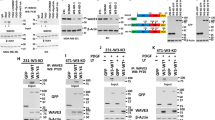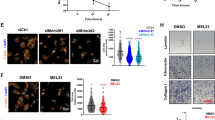Abstract
Mek1 and Mek2 (also known as Map2k1 and Map2k2, respectively) are evolutionarily conserved, dual-specificity kinases that mediate Erk1 and Erk2 activation during adhesion and growth factor signaling. Here we describe a previously uncharacterized, unexpected role of Mek1 in downregulating Mek2-dependent Erk signaling. Mek1 mediates the regulation of Mek2 in the context of a previously undiscovered Mek1–Mek2 complex. The Mek heterodimer is negatively regulated by Erk-mediated phosphorylation of Mek1 on Thr292, a residue missing in Mek2. Disabling this Erk-proximal negative-feedback step stabilizes the phosphorylation of both Mek2 and Erk in cultured cells and in vivo in Mek1 knockout embryos and mice. Thus, in disagreement with the current perception of the pathway, the role of Mek1 and Mek2 in growth factor–induced Erk phosphorylation is not interchangeable. Our data establish Mek1 as the crucial modulator of Mek and Erk signaling and have potential implications for the role of Mek1 and Mek2 in tumorigenesis.
This is a preview of subscription content, access via your institution
Access options
Subscribe to this journal
Receive 12 print issues and online access
$209.00 per year
only $17.42 per issue
Buy this article
- Purchase on SpringerLink
- Instant access to full article PDF
Prices may be subject to local taxes which are calculated during checkout






Similar content being viewed by others
Accession codes
References
Harding, A. & Hancock, J.F. Ras nanoclusters: combining digital and analog signaling. Cell Cycle 7, 127–134 (2008).
Kolch, W. Coordinating ERK/MAPK signalling through scaffolds and inhibitors. Nat. Rev. Mol. Cell Biol. 6, 827–837 (2005).
Orton, R.J. et al. Computational modelling of the receptor-tyrosine-kinase-activated MAPK pathway. Biochem. J. 392, 249–261 (2005).
Duesbery, N. & Vande Woude, G. BRAF and MEK mutations make a late entrance. Sci. STKE 2006, pe15 (2006).
Davies, H. et al. Mutations of the BRAF gene in human cancer. Nature 417, 949–954 (2002).
Estep, A.L., Palmer, C., McCormick, F. & Rauen, K.A. Mutation analysis of BRAF, MEK1 and MEK2 in 15 ovarian cancer cell lines: implications for therapy. PLoS ONE 2, e1279 (2007).
Huang, C., Jacobson, K. & Schaller, M.D. MAP kinases and cell migration. J. Cell Sci. 117, 4619–4628 (2004).
Fukuda, M., Gotoh, I., Adachi, M., Gotoh, Y. & Nishida, E. A novel regulatory mechanism in the mitogen-activated protein (MAP) kinase cascade. Role of nuclear export signal of MAP kinase kinase. J. Biol. Chem. 272, 32642–32648 (1997).
Brunet, A., Pages, G. & Pouyssegur, J. Growth factor-stimulated MAP kinase induces rapid retrophosphorylation and inhibition of MAP kinase kinase (MEK1). FEBS Lett. 346, 299–303 (1994).
Xu, B., Wilsbacher, J.L., Collisson, T. & Cobb, M.H. The N-terminal ERK-binding site of MEK1 is required for efficient feedback phosphorylation by ERK2 in vitro and ERK activation in vivo. J. Biol. Chem. 274, 34029–34035 (1999).
Schaeffer, H.J. et al. MP1: a MEK binding partner that enhances enzymatic activation of the MAP kinase cascade. Science 281, 1668–1671 (1998).
Roy, M., Li, Z. & Sacks, D.B. IQGAP1 is a scaffold for mitogen-activated protein kinase signaling. Mol. Cell. Biol. 25, 7940–7952 (2005).
Yin, G., Haendeler, J., Yan, C. & Berk, B.C. GIT1 functions as a scaffold for MEK1-extracellular signal-regulated kinase 1 and 2 activation by angiotensin II and epidermal growth factor. Mol. Cell. Biol. 24, 875–885 (2004).
Belanger, L.F. et al. Mek2 is dispensable for mouse growth and development. Mol. Cell. Biol. 23, 4778–4787 (2003).
Giroux, S. et al. Embryonic death of Mek1-deficient mice reveals a role for this kinase in angiogenesis in the labyrinthine region of the placenta. Curr. Biol. 9, 369–372 (1999).
Bissonauth, V., Roy, S., Gravel, M., Guillemette, S. & Charron, J. Requirement for Map2k1 (Mek1) in extra-embryonic ectoderm during placentogenesis. Development 133, 3429–3440 (2006).
Scholl, F.A. et al. Mek1/2 MAPK kinases are essential for mammalian development, homeostasis, and Raf-induced hyperplasia. Dev. Cell 12, 615–629 (2007).
Ohren, J.F. et al. Structures of human MAP kinase kinase 1 (MEK1) and MEK2 describe novel noncompetitive kinase inhibition. Nat. Struct. Mol. Biol. 11, 1192–1197 (2004).
Eblen, S.T. et al. Mitogen-activated protein kinase feedback phosphorylation regulates MEK1 complex formation and activation during cellular adhesion. Mol. Cell. Biol. 24, 2308–2317 (2004).
Hayashi, S., Lewis, P., Pevny, L. & McMahon, A.P. Efficient gene modulation in mouse epiblast using a Sox2Cre transgenic mouse strain. Mech. Dev. 119, S97–S101 (2002).
Tronche, F. et al. Disruption of the glucocorticoid receptor gene in the nervous system results in reduced anxiety. Nat. Genet. 23, 99–103 (1999).
Galabova-Kovacs, G. et al. Essential role of B-Raf in oligodendrocyte maturation and myelination during postnatal central nervous system development. J. Cell Biol. 180, 947–955 (2008).
Ussar, S. & Voss, T. MEK1 and MEK2, different regulators of the G1/S transition. J. Biol. Chem. 279, 43861–43869 (2004).
Santos, S.D., Verveer, P.J. & Bastiaens, P.I. Growth factor-induced MAPK network topology shapes Erk response determining PC-12 cell fate. Nat. Cell Biol. 9, 324–330 (2007).
Rossomando, A.J., Dent, P., Sturgill, T.W. & Marshak, D.R. Mitogen-activated protein kinase kinase 1 (MKK1) is negatively regulated by threonine phosphorylation. Mol. Cell. Biol. 14, 1594–1602 (1994).
Park, E.R., Eblen, S.T. & Catling, A.D. MEK1 activation by PAK: a novel mechanism. Cell. Signal. 19, 1488–1496 (2007).
Pike, A.C. et al. Activation segment dimerization: a mechanism for kinase autophosphorylation of non-consensus sites. EMBO J. 27, 704–714 (2008).
Buday, L., Warne, P.H. & Downward, J. Downregulation of the Ras activation pathway by MAP kinase phosphorylation of Sos. Oncogene 11, 1327–1331 (1995).
Sundberg-Smith, L.J., Doherty, J.T., Mack, C.P. & Taylor, J.M. Adhesion stimulates direct PAK1/ERK2 association and leads to ERK-dependent PAK1 Thr212 phosphorylation. J. Biol. Chem. 280, 2055–2064 (2005).
Dougherty, M.K. et al. Regulation of Raf-1 by direct feedback phosphorylation. Mol. Cell 17, 215–224 (2005).
Brummer, T., Naegele, H., Reth, M. & Misawa, Y. Identification of novel ERK-mediated feedback phosphorylation sites at the C-terminus of B-Raf. Oncogene 22, 8823–8834 (2003).
Weber, C.K., Slupsky, J.R., Kalmes, H.A. & Rapp, U.R. Active Ras induces heterodimerization of cRaf and BRaf. Cancer Res. 61, 3595–3598 (2001).
Garnett, M.J., Rana, S., Paterson, H., Barford, D. & Marais, R. Wild-type and mutant B-RAF activate C-RAF through distinct mechanisms involving heterodimerization. Mol. Cell 20, 963–969 (2005).
Rushworth, L.K., Hindley, A.D., O'Neill, E. & Kolch, W. Regulation and Role of Raf-1/B-Raf Heterodimerization. Mol. Cell. Biol. 26, 2262–2272 (2006).
Wellbrock, C., Karasarides, M. & Marais, R. The RAF proteins take centre stage. Nat. Rev. Mol. Cell Biol. 5, 875–885 (2004).
Moissoglu, K. & Schwartz, M.A. Integrin signalling in directed cell migration. Biol. Cell 98, 547–555 (2006).
Armant, D.R. Blastocysts don't go it alone. Extrinsic signals fine-tune the intrinsic developmental program of trophoblast cells. Dev. Biol. 280, 260–280 (2005).
Slack-Davis, J.K. et al. PAK1 phosphorylation of MEK1 regulates fibronectin-stimulated MAPK activation. J. Cell Biol. 162, 281–291 (2003).
Rodriguez-Viciana, P. et al. Germline mutations in genes within the MAPK pathway cause cardio-facio-cutaneous syndrome. Science 311, 1287–1290 (2006).
Corson, L.B., Yamanaka, Y., Lai, K.M. & Rossant, J. Spatial and temporal patterns of ERK signaling during mouse embryogenesis. Development 130, 4527–4537 (2003).
Mikula, M. et al. Embryonic lethality and fetal liver apoptosis in mice lacking the c-raf-1 gene. EMBO J. 20, 1952–1962 (2001).
Ehrenreiter, K. et al. Raf-1 regulates Rho signaling and cell migration. J. Cell Biol. 168, 955–964 (2005).
Wallace, I.M., O'Sullivan, O., Higgins, D.G. & Notredame, C. M-Coffee: combining multiple sequence alignment methods with T-Coffee. Nucleic Acids Res. 34, 1692–1699 (2006).
Do, C.B., Mahabhashyam, M.S., Brudno, M. & Batzoglou, S. ProbCons: Probabilistic consistency-based multiple sequence alignment. Genome Res. 15, 330–340 (2005).
Katoh, K., Misawa, K., Kuma, K. & Miyata, T. MAFFT: a novel method for rapid multiple sequence alignment based on fast Fourier transform. Nucleic Acids Res. 30, 3059–3066 (2002).
Edgar, R.C. MUSCLE: multiple sequence alignment with high accuracy and high throughput. Nucleic Acids Res. 32, 1792–1797 (2004).
Vinh le, S. & von Haeseler, A. IQPNNI: moving fast through tree space and stopping in time. Mol. Biol. Evol. 21, 1565–1571 (2004).
Acknowledgements
We thank T. Decker for critical reading of the manuscript, T. Zoranovic, C. Wasinger, M. Hamerl and the Max F. Perutz Laboratories (MFPL) animal house for outstanding technical assistance, I. Ebersberger (MFPL) for providing all ortholog Mek sequences listed in HaMSTR. This work was supported by FWF grants P19530 (to M.B.) and T196 (to V.J.).
Author information
Authors and Affiliations
Contributions
F.C., G.R., V.J., and G.G.-K. performed research; M.B. designed research; R.d.M.S. analyzed sequence information; O.C. performed molecular modelling; M.B. wrote the paper.
Corresponding author
Supplementary information
Supplementary Text and Figures
Supplementary Figures 1–5 and Supplementary Tables 1 and 2 (PDF 322 kb)
Rights and permissions
About this article
Cite this article
Catalanotti, F., Reyes, G., Jesenberger, V. et al. A Mek1–Mek2 heterodimer determines the strength and duration of the Erk signal. Nat Struct Mol Biol 16, 294–303 (2009). https://doi.org/10.1038/nsmb.1564
Received:
Accepted:
Published:
Issue Date:
DOI: https://doi.org/10.1038/nsmb.1564



